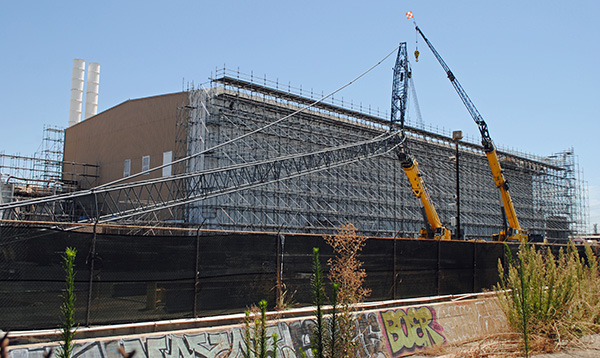By Alfredo Santana
Contributing Writer
VERNON — Airborne lead particles from scaffolding removed at the former Exide battery plant in May rose above environmental limits set by the local air quality district and the Environmental Protection Agency, according to records released during a virtual community briefing July 29.
Blown dust blended with lead particles logged on scaffolding covered with plastic tarps encapsulating segment 2 of the former Exide battery recycling caused flare ups and outdoor releases as strong winds picked up while crews dismembered the metal structures.
The uptick in releases, mostly detected by an air pollution monitor installed at a spot northeast of the plant near segment 2, caused a temporary shutdown of cleanup operations from mid-May to the second week of June. Segment 2 is a giant smelting structure decontaminated and now dismembered, according to the Vernon Environmental Trust Fund in charge of cleaning the site.
The virtual briefing had been delayed more than a month. It was organized by the California Department of Toxic Substances Control and the U.S. Environmental Protection Agency, in coordination with Vernon Environmental Trust Fund, entities in charge of supervising and monitoring the dismantling of the highly polluted battery smelter.
VERT trustee Roberto Puga said on May 13 a small plastic tear noticed by cleanup crews was documented and the following day reported to the South Coast Air Quality Management District and the EPA, so inspectors could measure the danger posed and conduct repairs.
Puga said the released airborne particles occurred when winds increased while crews started to disassemble Haki scaffolding encapsulated with tarps that mitigated dust and lead from segment 2 to reach surrounding residential communities. Additional holes in the plastic tarps were found and sealed.
He insisted that the releases did not violate emission thresholds, and none surfaced from the ground up or originated from the dismembered segment 2.
“The AQMD was very proactive in identifying the monitor with exceeded measures,” Puga said. “It was a Friday night. By then we already knew and stopped proactively and voluntarily.”
EPA project manager Amanda Cruz said the agency established emissions standards for 30 and 90 days with rule 1420, and the releases violated it.
“One outside monitor detected levels above rule 1420,” Cruz said.
Lead concentration levels in the air measured 0.0289 micrograms per cubic meter on May 13, with the highest of 0.495 gauged May 21. The VERT is required to notify monitoring agencies whenever airborne particles reach 0.3 micrograms per cubic meter.
Three additional air monitors did not tally an increase of lead particles in the air during the emergency, and negative pressure on segment 3, another large unit slated to be dismantled, remained steady.
Sustained gusts measured at 31.8 miles per hour on May 21 caused a momentary flare up above 0.5 micrograms per cubic meter, the highest concentration level recorded since the VERT took over the site’s cleanup last October following a bankruptcy mandate that created the cleanup trust, Puga said.
When inspectors identified the pollution source, crews equipped a giant crane with a water cannon and doused the scaffolding, abating dust and airborne pollution.
Full-time cleanup work resumed June 21. Four of six smokestacks recently coated to capture asbestos and seal the outside juncture with the roof had been sliced off before teardown of segment 3 begins, the trustee said.
Jason Aspell, assistant deputy executive officer of engineering and permitting with the AQMD, confirmed that an air ambience monitor installed at Resurrection Catholic Church in Boyle Heights did not detect upticks in lead emissions during the plant’s shutdown.
The church is located about 1.5 miles northwest of the facility, and the site has been used as a hub for community organizations to find solutions to the environmental catastrophe Exide Technologies and the plant’s former operators wrought on 10,000 homes and area residents, releasing lead and arsenic dust for decades.
The blue-collar neighborhoods of Boyle Heights, Huntington Park, Commerce, Maywood, East Los Angeles and Bell received the brunt of toxic metal emissions since the plant started recycling batteries in 1922.
Also, the church has been used by local and state officials as a conference platform to announce legal actions against former Exide management and pledge support for $454.5 million in public funds allocated by Gov. Gavin Newsom in this year’s state budget to decontaminate up to 6,800 more homes and finish the cleanup at the battery plant.
“Area leaders were notified of the releases, and we contacted representatives of the affected communities in East Los Angeles,” Aspell said, including county Supervisor Hilda Solis.
In addition, the VERT trust petitioned the city of Vernon to ban truck parking on Indiana Street at the curbside adjacent to the plant, due to images picked up by a drone that noticed a tire repair truck servicing a big rig using air shop to undust wheels before replacing them.
Until July 31, the curbside had not been painted red. Although it is unclear if truck servicing near the plant’s perimeter contributed to climbing airborne particles, Puga said the trust wanted to get rid of any potential culprits, and added street sweeping near the perimeter in the industrial corridor may contribute to flare-ups.
Currently, water mist lines placed atop metal fences surrounding structures being dismantled mitigate dust that may escape from the base, outdoor paint or pieces of scaffolding already dislodged or about to be dismembered.
Grant Cope, Department of Toxic Substances Control’s site mitigation and restoration deputy director, said that when emergencies “like this pop up, it’s important to identify them first and act rapidly.”
In a related matter, community resident Mariabella Muro criticized the Department of Toxic Substances Control for failing to update the community on the temporary cleanup stoppage, and blamed the agency for an encroaching culture where crews conducting soil excavations at homes refuse to talk to residents about the potential drawbacks of these jobs.
“The excavations are happening, but nobody in my family had been informed about the consequences of tests or the work done. Are there consequences for the jobs being done?” Muro asked.
Cruz said that since Exide relinquished control of the site last October, the EPA took on the job of making public communications on the latest developments related to the cleanup project. She encouraged stakeholders to visit the agency’s California website for weekly updates every Tuesday.
As crews prepare to tackle segment 3 decontamination, Puga acknowledged the flare-ups call for more effective safety measures at the site to tame present dangers.
“We’ve got to be very careful,” he said. “We learned that when the scaffolding was taken down, the potential for releases are there. We need to control potential clusters of lead particles and mitigate them first.”












